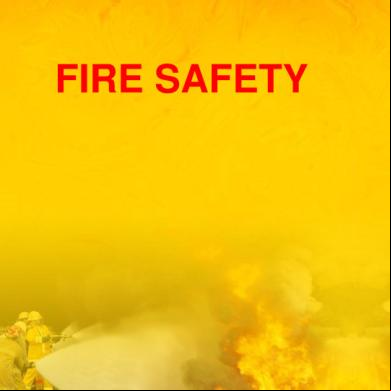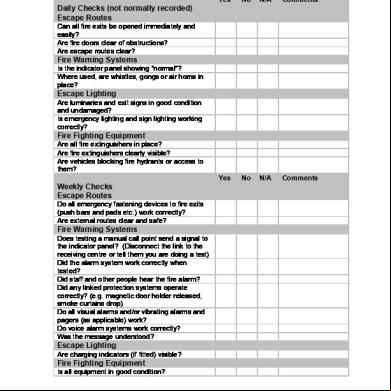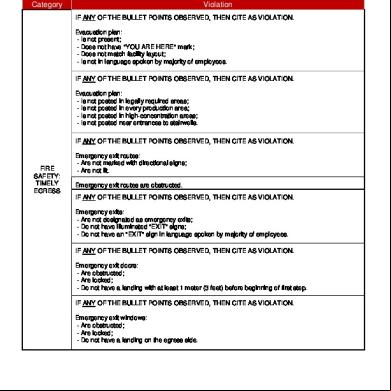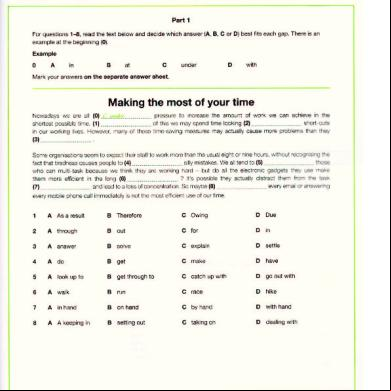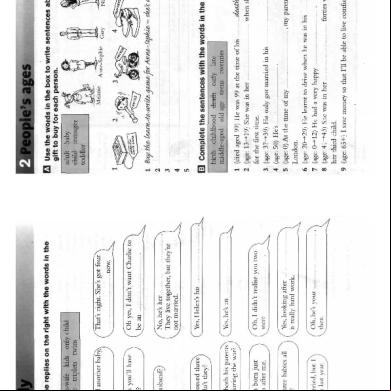Fire Safety 4cw
This document was ed by and they confirmed that they have the permission to share it. If you are author or own the copyright of this book, please report to us by using this report form. Report 3b7i
Overview 3e4r5l
& View Fire Safety as PDF for free.
More details w3441
- Words: 1,772
- Pages: 36
FIRE SAFETY
Definition of fire • FIRE - chemical reaction between oxygen in the atmosphere and some sort of fuel
The Fire Three things must be present at the same time to produce fire: 1. Enough Oxygen to sustain combustion
2. Enough Heat to reach ignition temperature
3. Some FUEL or combustible material Together, they produce the CHEMICAL REACTION that is fire • Take away any of these things and the fire will be extinguished
The Fire Triangle
Fire Safety, at its most basic, is based upon the principle of keeping fuel sources and ignition sources separate
Fire Classifications • Fires are classified according to the type of fuel that is burning. • If you use the wrong type of fire extinguisher on the wrong class of fire, you might make matters worse. • Its very important to understand the five different fire (fuel) classifications
cont…..
Fire Classifications Class A: Wood, paper, cloth, trash, plastics—solids that are not metals. Class B: Flammable liquids—gasoline, oil, grease, acetone. Includes flammable gases.
Class C: Electrical—energized electrical equipment. As long as it’s “plugged in.” D
Class D: Metals—potassium, sodium, aluminum, magnesium. Requires Metal-X, foam, and other special extinguishing agents. Class K: Fires involving combustible vegetable or animal non-saturated cooking fats in commercial cooking equipment.
Fire Extinguisher Anatomy DISCHARGE LEVER
DISCHARGE LOCKING PIN AND SEAL
PRESSURE GAUGE (not found on CO2 extinguishers) CARRYING HANDLE
DISCHARGE HOSE
DATA PLATE
DISCHARGE NOZZLE
DISCHARGE ORIFICE
BODY
Information on Fire extinguishers
FIRE EXTINGUISHER METHOD OF OPERATION • Stored pressure • When lever of an extinguisher is compressed, it opens an inner canister of high pressure gas (Nitrogen / CO2) • The high pressure gas forces the extinguishing agent from main cylinder through siphon tube and out the nozzle.
Fire Extinguisher Applications FIRE CLASS A
EFFECTIVE EXTINGUISHER TYPES
Trash Wood Paper
PRESSURIZED WATER, MULTIPURPOSE DRY CHEMICAL, LARGER SIZE HALON, WET CHEMICAL B
Liquids
Grease
MULTIPURPOSE DRY CHEMICAL, CARBON DIOXIDE, HALON
C
Electrical Equipment
MULTIPURPOSE DRY CHEMICAL, CARBON DIOXIDE, HALON, WET CHEMICAL COMBUSTIBLE
D
COMBUSTIBLE METAL
METALS
K Cooking Media
WET CHEMICAL
Fire Extinguisher Types PRESSURIZED WATER • Class “A” fires only.
A Trash Wood Paper A Trash Wood Paper
• 2.5 gal. water at 150-175 psi (up to 1 minute discharge time). B
• Has pressure gauge to allow visual capacity check.
B
Liquids Grease Liquids Grease
• 30-40 ft. maximum effective range. C
• Extinguishes by cooling burning material below the ignition point.
C
Electrical Equipment Electrical Equipment
CARBON DIOXIDE (CO2) • Class “B” or “C” fires. • 2.5-100 lb. of CO2 gas at 150-200 psi (8-30 seconds discharge time). • Has NO pressure gauge--capacity verified by weight. • 3-8 ft. maximum effective range. • Extinguishes by smothering burning materials. • Effectiveness decreases as temperature of burning material increases.
A Trash Wood Paper A Trash Wood Paper
B
C
C
B
Liquids Grease Liquids Grease
Electrical Equipment Electrical Equipment
MULTIPURPOSE DRY CHEMICAL • Class “A”, “B”, or “C” fires. A Trash Wood Paper A Trash Wood Paper
• 2.5-20 lb. dry chemical (ammonium phosphate) pressurized to 50-200 psi by nitrogen gas (8-25 seconds discharge time). B
B
Liquids Grease Liquids Grease
• Has pressure gauge to allow visual capacity check. C
• 5-20 ft. maximum effective range. • Extinguishes by smothering burning materials.
C
Electrical Equipment Electrical Equipment
HALON • Class “A”, “B”, or “C” fires (smaller sizes ineffective against Class “A”). • 9-17 lb. Halon 1211 (pressurized liquid) released as vapor (8-18 seconds discharge time). • Has pressure gauge to allow visual capacity check. • 9-16 ft. maximum effective range. • Works best in confined area--ideal for electronics fire due to lack of residue. • Extinguishes by smothering burning materials. • Fumes toxic if inhaled. • Halon is ozone depleting chemical-production halted in Jan „94.
A Trash Wood Paper A Trash Wood Paper
B
C
C
B
Liquids Grease Liquids Grease
Electrical Equipment Electrical Equipment
COMBUSTIBLE METAL • Class “D” combustible metal fires only. • 30 lb. pressurized dry powder optimized for specific combustible metal (also available in bulk containers for hand scooping onto fire to extinguish). • 6-8 ft. maximum effective range. • To activate, must first open nitrogen cylinder on back to pressurize body. • Extinguishes by smothering burning materials.
D
WET CHEMICAL • Class “A”, “C”, and “K” fires. • 1.5 gal. of stored pressure (40 sec. discharge time). • 10-12 ft. maximum effective range. • On Class “K” fires, don‟t use until after fixed extinguishing system has activated. • Extinguishes by cooling and forming foam blanket to prevent reignition.
A Trash Wood Paper A Trash Wood Paper
C Electrical Equipment C Electrical Equipment
Fire Extinguisher Summary EXTINGUISHER TYPE
WORKS BY
PRESSURIZED WATER
COOLING
CARBON DIOXIDE
SMOTHERING
MULTIPURPOSE DRY CHEMICAL
SMOTHERING
HALON
SMOTHERING
COMBUSTIBLE METAL
SMOTHERING
WET CHEMICAL
COOLING/ SMOTHERING
EFFECTIVE AGAINST
D
Fighting the Fire
P
Pull the pin
A
Aim low at the base of flames Squeeze the Handle Sweep side to side
S S
Fire protection system Active fire protection WATER BASE SYSTEM
POWDER BASE SYSTEM GAS BASE SYSTEM
ive fire protection Smoke Detectors Heat Detectors Flame detectors
Water based system Hydrant System – It consists of the following • • • • • •
components: Sufficiently large water reservoir Fire pump sets (Main and Standby) Jockey pump set Hydrant valves Fire fighting hoses Branch pipe with nozzles
The entire pipeline is kept pressurized with water
Foam system • Firefighting foam is a stable mass of small, air-filled bubbles with a lower density than oil, gasoline, or water. • Foam is made up of three ingredients water, a foam concentrate, and air. • Foam blankets the fuel surface, smothering the fire and separating the flames from the fuel surface. • The fuel is cooled by the water content of the foam
Sprinkler system • A fire sprinkler system is an active fire protection measure, consisting of a water supply system, providing adequate pressure and flow rate to a water. • operate at a preset temperature, utilizing a fusible link, a portion of which melts allowing the plug in the orifice to be pushed out by the water.
Spray System • It is typical used in high hazard applications where the need to discharge large quantities of water on the areas of fire.
• When it is broken up into fine, misty spray and when the entire surface of vaporizing liquid can be covered simultaneously, water spray is effective in extinguishing the flames
Smoke Detectors • Smoke detectors detect the visible or invisible smoke particles from combustion • The two main types are ionization detectors and photoelectric detectors Ionization Detectors Photoelectric Detectors
Ionization Detectors • It contains a small radioactive source that is used to charge the air inside a small chamber. The charged air allows a small current to cross through the chamber and complete an electrical circuit. • When smoke enters the chamber, it shields the radiation, which stops the current and triggers an alarm
Photoelectric Detectors • a light source and light sensor are arranged so that the rays from the light source do not hit the light sensor • When smoke particles enter the light path, some of the light is scattered and redirected onto the sensor, causing the detector to activate an alarm
HOW FIRE SPREADS THROUGH YOUR WORKPLACE • Fire in enclosed space behave differently to fires in the open air • Smoke rising from fire gets trapped by ceiling • Smoke spreads in all directions to form a layer over the entire room • Smoke will through any holes/gaps in the walls, ceilings or floor and finally other parts • Heat also get trapped, increasing the temperature
Fight OR Escape • Before attempting to fight any fire with an extinguisher, ask yourself the following questions N LEAVE IMMEDIATELY!
Can I escape quickly and safely from area if I attempt to extinguish the fire? Y N
LEAVE IMMEDIATELY!
Do I have the right type of extinguisher? Y
N
Is the extinguisher large enough for the fire?
LEAVE IMMEDIATELY!
Y Is the area free from other dangers such as hazardous materials ? Y EXTINGUISH THE FIRE!
N
LEAVE IMMEDIATELY!
COMMON CAUSES OF FIRE • Electrical short circuit and overloading • Overheating of electrical appliances • Smouldering cigarette • Mishandling and storage of chemicals • “Hot Work” • Human errors
FIRE PREVENTIVE MEASURES
Check the Workplace • are separate storage arrangements for flammable chemicals, gas cylinders, and waste materials available and clearly marked • is combustible waste regularly and safely disposed of • if smoking is allowed in the workplace, are there satisfactory arrangements for cigarettes and matches to be disposed of safely and separately from other combustible rubbish • are clear fire instructions displayed throughout the workplace • is electrical equipment serviced regularly to prevent sparks and fires
Fire Drills • are they carried out regularly and at least once per year (preferably once every 6 months); • are non-employees such as residents, pupils, contractors, etc. included; • are particular arrangements necessary for the evacuation of people with disabilities, the elderly, the sick, and young children; • are they observed by designated staff who report on how long it took to evacuate the workplace, what went correctly and what went wrong, and are faults put right before the next drill; • does management keep records of drills and training with details of any problems found and the action taken to put them right.
Training for Employees • are all employees given information, instruction, and training by a competent person on: - fire risks and precautions to be taken to avoid fire, - what to do if they discover a fire, - raising the alarm, including location of alarm call points, - recognising the fire alarm and what to do when it is raised, - calling the fire brigade, - evacuation procedures, including arrangements for of the public, and people with disabilities, and - escape routes, fire exits, and assembly areas;
Safety Precautions During Evacuation • When traveling through smoke and/or fire, to keep low, wrap patients in wet blankets and keep faces covered • Do not run! • Do not open a door into an area where a suspected fire might be. To check doors: • Brace your shoulder and foot against the door and slowly open it • If smoke seeps through, close the door • If there is no heat or smoke, proceed to evacuate
• Close all doors as you • Do not allow anyone to return to the area
References • • • • • •
www.nifsindia.net www.ushafire.com www.firesafety.gov www.ceasefiresafety.com www.ilpi.com/safety/extinguishers.html www.communities.gov.uk/firesafety
Thank you
Definition of fire • FIRE - chemical reaction between oxygen in the atmosphere and some sort of fuel
The Fire Three things must be present at the same time to produce fire: 1. Enough Oxygen to sustain combustion
2. Enough Heat to reach ignition temperature
3. Some FUEL or combustible material Together, they produce the CHEMICAL REACTION that is fire • Take away any of these things and the fire will be extinguished
The Fire Triangle
Fire Safety, at its most basic, is based upon the principle of keeping fuel sources and ignition sources separate
Fire Classifications • Fires are classified according to the type of fuel that is burning. • If you use the wrong type of fire extinguisher on the wrong class of fire, you might make matters worse. • Its very important to understand the five different fire (fuel) classifications
cont…..
Fire Classifications Class A: Wood, paper, cloth, trash, plastics—solids that are not metals. Class B: Flammable liquids—gasoline, oil, grease, acetone. Includes flammable gases.
Class C: Electrical—energized electrical equipment. As long as it’s “plugged in.” D
Class D: Metals—potassium, sodium, aluminum, magnesium. Requires Metal-X, foam, and other special extinguishing agents. Class K: Fires involving combustible vegetable or animal non-saturated cooking fats in commercial cooking equipment.
Fire Extinguisher Anatomy DISCHARGE LEVER
DISCHARGE LOCKING PIN AND SEAL
PRESSURE GAUGE (not found on CO2 extinguishers) CARRYING HANDLE
DISCHARGE HOSE
DATA PLATE
DISCHARGE NOZZLE
DISCHARGE ORIFICE
BODY
Information on Fire extinguishers
FIRE EXTINGUISHER METHOD OF OPERATION • Stored pressure • When lever of an extinguisher is compressed, it opens an inner canister of high pressure gas (Nitrogen / CO2) • The high pressure gas forces the extinguishing agent from main cylinder through siphon tube and out the nozzle.
Fire Extinguisher Applications FIRE CLASS A
EFFECTIVE EXTINGUISHER TYPES
Trash Wood Paper
PRESSURIZED WATER, MULTIPURPOSE DRY CHEMICAL, LARGER SIZE HALON, WET CHEMICAL B
Liquids
Grease
MULTIPURPOSE DRY CHEMICAL, CARBON DIOXIDE, HALON
C
Electrical Equipment
MULTIPURPOSE DRY CHEMICAL, CARBON DIOXIDE, HALON, WET CHEMICAL COMBUSTIBLE
D
COMBUSTIBLE METAL
METALS
K Cooking Media
WET CHEMICAL
Fire Extinguisher Types PRESSURIZED WATER • Class “A” fires only.
A Trash Wood Paper A Trash Wood Paper
• 2.5 gal. water at 150-175 psi (up to 1 minute discharge time). B
• Has pressure gauge to allow visual capacity check.
B
Liquids Grease Liquids Grease
• 30-40 ft. maximum effective range. C
• Extinguishes by cooling burning material below the ignition point.
C
Electrical Equipment Electrical Equipment
CARBON DIOXIDE (CO2) • Class “B” or “C” fires. • 2.5-100 lb. of CO2 gas at 150-200 psi (8-30 seconds discharge time). • Has NO pressure gauge--capacity verified by weight. • 3-8 ft. maximum effective range. • Extinguishes by smothering burning materials. • Effectiveness decreases as temperature of burning material increases.
A Trash Wood Paper A Trash Wood Paper
B
C
C
B
Liquids Grease Liquids Grease
Electrical Equipment Electrical Equipment
MULTIPURPOSE DRY CHEMICAL • Class “A”, “B”, or “C” fires. A Trash Wood Paper A Trash Wood Paper
• 2.5-20 lb. dry chemical (ammonium phosphate) pressurized to 50-200 psi by nitrogen gas (8-25 seconds discharge time). B
B
Liquids Grease Liquids Grease
• Has pressure gauge to allow visual capacity check. C
• 5-20 ft. maximum effective range. • Extinguishes by smothering burning materials.
C
Electrical Equipment Electrical Equipment
HALON • Class “A”, “B”, or “C” fires (smaller sizes ineffective against Class “A”). • 9-17 lb. Halon 1211 (pressurized liquid) released as vapor (8-18 seconds discharge time). • Has pressure gauge to allow visual capacity check. • 9-16 ft. maximum effective range. • Works best in confined area--ideal for electronics fire due to lack of residue. • Extinguishes by smothering burning materials. • Fumes toxic if inhaled. • Halon is ozone depleting chemical-production halted in Jan „94.
A Trash Wood Paper A Trash Wood Paper
B
C
C
B
Liquids Grease Liquids Grease
Electrical Equipment Electrical Equipment
COMBUSTIBLE METAL • Class “D” combustible metal fires only. • 30 lb. pressurized dry powder optimized for specific combustible metal (also available in bulk containers for hand scooping onto fire to extinguish). • 6-8 ft. maximum effective range. • To activate, must first open nitrogen cylinder on back to pressurize body. • Extinguishes by smothering burning materials.
D
WET CHEMICAL • Class “A”, “C”, and “K” fires. • 1.5 gal. of stored pressure (40 sec. discharge time). • 10-12 ft. maximum effective range. • On Class “K” fires, don‟t use until after fixed extinguishing system has activated. • Extinguishes by cooling and forming foam blanket to prevent reignition.
A Trash Wood Paper A Trash Wood Paper
C Electrical Equipment C Electrical Equipment
Fire Extinguisher Summary EXTINGUISHER TYPE
WORKS BY
PRESSURIZED WATER
COOLING
CARBON DIOXIDE
SMOTHERING
MULTIPURPOSE DRY CHEMICAL
SMOTHERING
HALON
SMOTHERING
COMBUSTIBLE METAL
SMOTHERING
WET CHEMICAL
COOLING/ SMOTHERING
EFFECTIVE AGAINST
D
Fighting the Fire
P
Pull the pin
A
Aim low at the base of flames Squeeze the Handle Sweep side to side
S S
Fire protection system Active fire protection WATER BASE SYSTEM
POWDER BASE SYSTEM GAS BASE SYSTEM
ive fire protection Smoke Detectors Heat Detectors Flame detectors
Water based system Hydrant System – It consists of the following • • • • • •
components: Sufficiently large water reservoir Fire pump sets (Main and Standby) Jockey pump set Hydrant valves Fire fighting hoses Branch pipe with nozzles
The entire pipeline is kept pressurized with water
Foam system • Firefighting foam is a stable mass of small, air-filled bubbles with a lower density than oil, gasoline, or water. • Foam is made up of three ingredients water, a foam concentrate, and air. • Foam blankets the fuel surface, smothering the fire and separating the flames from the fuel surface. • The fuel is cooled by the water content of the foam
Sprinkler system • A fire sprinkler system is an active fire protection measure, consisting of a water supply system, providing adequate pressure and flow rate to a water. • operate at a preset temperature, utilizing a fusible link, a portion of which melts allowing the plug in the orifice to be pushed out by the water.
Spray System • It is typical used in high hazard applications where the need to discharge large quantities of water on the areas of fire.
• When it is broken up into fine, misty spray and when the entire surface of vaporizing liquid can be covered simultaneously, water spray is effective in extinguishing the flames
Smoke Detectors • Smoke detectors detect the visible or invisible smoke particles from combustion • The two main types are ionization detectors and photoelectric detectors Ionization Detectors Photoelectric Detectors
Ionization Detectors • It contains a small radioactive source that is used to charge the air inside a small chamber. The charged air allows a small current to cross through the chamber and complete an electrical circuit. • When smoke enters the chamber, it shields the radiation, which stops the current and triggers an alarm
Photoelectric Detectors • a light source and light sensor are arranged so that the rays from the light source do not hit the light sensor • When smoke particles enter the light path, some of the light is scattered and redirected onto the sensor, causing the detector to activate an alarm
HOW FIRE SPREADS THROUGH YOUR WORKPLACE • Fire in enclosed space behave differently to fires in the open air • Smoke rising from fire gets trapped by ceiling • Smoke spreads in all directions to form a layer over the entire room • Smoke will through any holes/gaps in the walls, ceilings or floor and finally other parts • Heat also get trapped, increasing the temperature
Fight OR Escape • Before attempting to fight any fire with an extinguisher, ask yourself the following questions N LEAVE IMMEDIATELY!
Can I escape quickly and safely from area if I attempt to extinguish the fire? Y N
LEAVE IMMEDIATELY!
Do I have the right type of extinguisher? Y
N
Is the extinguisher large enough for the fire?
LEAVE IMMEDIATELY!
Y Is the area free from other dangers such as hazardous materials ? Y EXTINGUISH THE FIRE!
N
LEAVE IMMEDIATELY!
COMMON CAUSES OF FIRE • Electrical short circuit and overloading • Overheating of electrical appliances • Smouldering cigarette • Mishandling and storage of chemicals • “Hot Work” • Human errors
FIRE PREVENTIVE MEASURES
Check the Workplace • are separate storage arrangements for flammable chemicals, gas cylinders, and waste materials available and clearly marked • is combustible waste regularly and safely disposed of • if smoking is allowed in the workplace, are there satisfactory arrangements for cigarettes and matches to be disposed of safely and separately from other combustible rubbish • are clear fire instructions displayed throughout the workplace • is electrical equipment serviced regularly to prevent sparks and fires
Fire Drills • are they carried out regularly and at least once per year (preferably once every 6 months); • are non-employees such as residents, pupils, contractors, etc. included; • are particular arrangements necessary for the evacuation of people with disabilities, the elderly, the sick, and young children; • are they observed by designated staff who report on how long it took to evacuate the workplace, what went correctly and what went wrong, and are faults put right before the next drill; • does management keep records of drills and training with details of any problems found and the action taken to put them right.
Training for Employees • are all employees given information, instruction, and training by a competent person on: - fire risks and precautions to be taken to avoid fire, - what to do if they discover a fire, - raising the alarm, including location of alarm call points, - recognising the fire alarm and what to do when it is raised, - calling the fire brigade, - evacuation procedures, including arrangements for of the public, and people with disabilities, and - escape routes, fire exits, and assembly areas;
Safety Precautions During Evacuation • When traveling through smoke and/or fire, to keep low, wrap patients in wet blankets and keep faces covered • Do not run! • Do not open a door into an area where a suspected fire might be. To check doors: • Brace your shoulder and foot against the door and slowly open it • If smoke seeps through, close the door • If there is no heat or smoke, proceed to evacuate
• Close all doors as you • Do not allow anyone to return to the area
References • • • • • •
www.nifsindia.net www.ushafire.com www.firesafety.gov www.ceasefiresafety.com www.ilpi.com/safety/extinguishers.html www.communities.gov.uk/firesafety
Thank you
